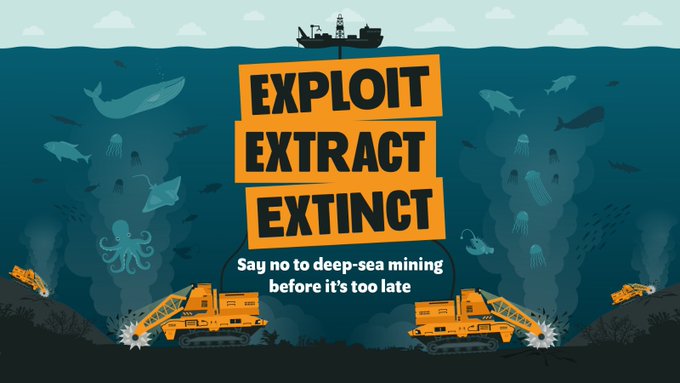Is Balancing Resource Quest and Environmental Stewardship in the Abyssal Plains Possible?

The vast expanse of the world's oceans holds untold treasures, including mineral resources that have the potential to meet the growing demands of various industries. Deep sea mining, a relatively nascent industry, has emerged as a potential solution to address the scarcity of minerals on land. However, as we explore the importance of deep sea mining, it is crucial to weigh its benefits against the potential long term environmental consequences.
Undersea mining targets several valuable metals that are in high demand for various industries. The primary metals of interest include:
- Manganese: production of steel, batteries, particularly in the cathodes of lithium-ion batteries.
- Nickel:stainless steel production, and in electric vehicle (EV) batteries.
- Cobalt: lithium-ion batteries in portable electronics, EVs, and energy storage systems and aerospace industry and in some alloys.
- Copper: electrical wiring, electronics, plumbing, and construction.
- Zinc: galvanizing steel, and production of alloys, batteries, and as a nutrient in agriculture.
- Silver: electronics, jewelry, photography, and the medical industry.
Deep sea mining involves the extraction of minerals from the ocean floor, primarily in the deep abyssal plains, underwater volcanoes, and hydrothermal vents. These regions harbor valuable resources such as polymetallic nodules (containing manganese, nickel, cobalt, and copper) at depths of around 4,000 to 6,000 meters (13,000 to 20,000 feet), cobalt-rich crusts at depths ranging from a few hundred meters to around 2,500 meters (800 to 8,200 feet), and seafloor massive sulfides (containing copper, gold, zinc, and silver) at depths ranging from a few hundred meters to around 2,000 meters (650 to 6,500 feet). The formation of polymetallic nodules on the seafloor is a slow geological process that can take millions of years. Sulfide deposits can develop over thousands to tens of thousands of years.
Why is there undersea mining when they can mine on land?
Undersea mining has gained attention and interest due to several reasons, despite the presence of land-based mining options. Here are some factors that contribute to the exploration of undersea mining:
- Resource Scarcity: Many terrestrial deposits of valuable metals are becoming increasingly depleted or harder to access. Undersea mining offers an opportunity to tap into new sources of these metals to meet the growing global demand. Also, the concentration of the minerals can be much higher than on land.
- Potential for Untapped Resources: The undersea environment holds vast, relatively unexplored mineral resources. Exploiting these resources can help diversify the global supply and reduce dependence on land-based mining.
- Technological Advancements: Advances in deep-sea exploration technologies, robotics, and remote sensing have made it more feasible to explore and potentially extract minerals from the ocean floor. These technological advancements have sparked interest in the economic viability of undersea mining operations.
- Strategic Considerations: Some countries may view undersea mining as a means to enhance their resource independence and reduce reliance on foreign sources. Accessing mineral resources within their exclusive economic zones (EEZs) can provide strategic advantages and support domestic industries.
- Environmental Impact Mitigation: Compared to land-based mining, undersea mining can be perceived as having a potentially lower impact on terrestrial ecosystems and communities. By mining in the deep sea, the direct disturbance to land ecosystems, such as deforestation and habitat destruction, can be avoided.
Deep-sea mining operations typically involve specific equipment used and can vary depending on the type of mineral deposit being targeted.
Here are some common tools and technologies utilized in deep-sea mining:
- Remotely Operated Vehicles (ROVs): ROVs are unmanned underwater vehicles equipped with cameras, robotic arms, and various sensors. They are used to explore the seafloor, collect samples, and perform tasks such as drilling, cutting, and lifting operations. ROVs are remotely controlled from the surface and provide real-time feedback to operators.
- Seafloor Crawlers: These are robotic machines designed to crawl along the seafloor and collect mineral deposits. They are equipped with cutting and suction devices to extract nodules or crusts. Seafloor crawlers are often tethered to a surface vessel and controlled remotely.
- Dredging Systems: Dredging systems are used to extract loose sediments and mineral-rich materials from the seafloor. They typically consist of a dredging vessel with a large suction pump connected to a pipe or hose. The pump sucks up the sediment, which is then transported to the surface for processing.
- Vertical Transport Systems: Once the mineral-rich material is extracted, it needs to be transported to the surface. Vertical transport systems, such as riser pipes or conveyors, are used to lift the material from the seafloor to the surface vessel for further processing.
- Processing Equipment: Onboard the surface vessel, processing equipment is used to separate and refine the extracted minerals. This can include crushing and grinding machinery, flotation cells, and various separation techniques to separate valuable minerals from the extracted material.
- Support Vessels and Infrastructure: Deep-sea mining operations require support vessels that serve as a base for equipment deployment, personnel accommodation, and logistical support. These vessels provide a platform for the operation and maintenance of the mining equipment.
The International Seabed Authority (ISA), established under the United Nations Convention on the Law of the Sea (UNCLOS) made up of 168 nations, is responsible for regulating deep sea mining activities in international waters. The ISA aims to ensure the sustainable development of seabed resources while safeguarding the marine environment. Additionally, some countries have enacted national legislation to govern mining in their respective EEZs.
Deep sea mining does pose potential risks to the marine ecosystem. These concerns include:
- Habitat Destruction: The extraction process, involving seabed sediment plumes and machinery, can disrupt delicate deep-sea ecosystems and destroy fragile habitats.
- Biodiversity Loss: Unique species adapted to extreme deep-sea conditions may face displacement or extinction due to mining activities.
- Water Quality Impacts: The release of sediment plumes and chemicals used in mining processes can affect water quality and vital ecological processes, such as nutrient cycling.
- Uncertainty: Limited knowledge about deep-sea ecosystems and their interconnectedness hampers accurate predictions of the long-term impacts of mining.
While comprehensive predictions are challenging, scientific studies suggest potential severe consequences. The long-term recovery of deep-sea ecosystems from mining disturbances remains uncertain and warrants further research before any mining takes place.
If deep-sea mining were to cause a loss of biodiversity and disrupt the long-term carbon cycle, the impacts would likely be felt globally, as the deep-sea ecosystems are interconnected and contribute to the overall health of the planet. However, specific regions and states that would be most impacted could vary depending on several factors, including the location and extent of mining operations and the vulnerability of the local ecosystems.
Here are a few considerations:
- Areas of Mining Operations: States with active deep-sea mining operations or those granting licenses for such activities would face immediate and direct impacts. For example, regions in the Pacific Ocean, such as the Clarion-Clipperton Zone (CCZ), are rich in polymetallic nodules and have attracted interest from mining companies. Thus, states in this region, including Pacific island nations and coastal countries like Mexico and Peru, could potentially experience significant ecological disruption and loss of biodiversity.
- Biodiversity Hotspots: Certain regions in the deep sea, like hydrothermal vents and seamounts, are known for their high biodiversity and unique ecosystems. If mining were to occur in these areas, it could have severe consequences for the endemic species that inhabit these hotspots. States with such biodiversity hotspots, like those with territories in the mid-Atlantic Ridge or the Indian Ocean, could experience substantial biodiversity loss.
- Carbon Cycling and Climate Impacts: The deep-sea plays a crucial role in the global carbon cycle. Organisms in the ocean absorb carbon dioxide and help regulate the Earth's climate. Disruptions in the long-term carbon cycle due to mining activities could affect carbon sequestration and potentially contribute to climate change. All states and regions would be impacted by such disruptions, as climate change has widespread and global consequences.
We support the moratorium on deep sea mining with more transparency, regulation and science being applied to studying its effects. For more information - please visit:
Defendthedeep.org - Call on governments to take action now and protect the health of our ocean for future generations
only.one/act/mining Add your name to the official letter to stop deep-sea mining, and we’ll deliver your signature to United Nations and International Seabed Authority Leaders.



Share:
Decoding the Depths: Unveiling the Hidden Depths of Dive Training Agencies
Exploring the World's Extraordinary Dive Sites: Finding the Perfect Fit